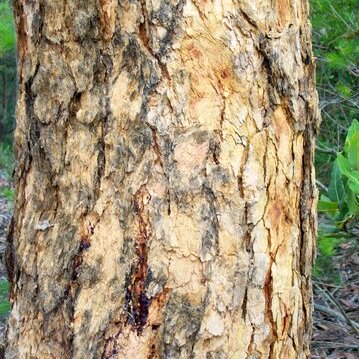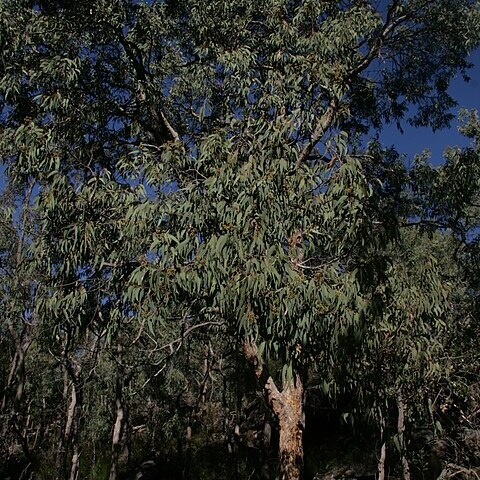Tree to 20 m tall. Forming a lignotuber. Bark rough to small branches, tessellated, flaky, yellow-brown to yellow and grey. Juvenile growth (coppice or field seedlings to 50 cm): stem rounded in cross-section; juvenile leaves opposite for 3 to 6 nodes, then alternate, always petiolate, peltate (at least to ca node 15), ovate at first then lanceolate to falcate, 4–21 cm long, 2.5–8 cm wide, base rounded, green to grey-green; scabrid on stems, petioles and lamina for up to ca 10 nodes.Adult leaves alternate, petiole 1.5–3.5 cm long; blade lanceolate to falcate, 10–24 cm long, 1.7–6 cm wide, base tapering to petiole or rounded, concolorous, slightly glossy or dull, green to grey-green, strongly penniveined, densely to very densely reticulate, intramarginal vein parallel to and just within margin, oil glands island.Inflorescence terminal compound, peduncles 1.5–4 cm long, buds 7 per umbel, sessile or pedicels to 0.4 cm long. Mature buds pyriform to obovoid, 1–1.3 cm long, 0.7–1 cm wide, green to yellow, scar present (outer operculum shed during bud development), operculum conical to beaked, stamens inflexed, anthers cuboid to oblong, versatile, dorsifixed, dehiscing by longitudinal slits (non-confluent), style long, stigma tapered, locules 3 or 4, the placentae each with 5 vertical ovule rows. Flowers white.Fruit sessile to shortly pedicellate (pedicels 0–0.2 cm long), barrel-shaped to urceolate, 1–1.9 cm long, 1–1.6 cm wide, disc descending, valves 3 or 4, enclosed.Seeds reddish brown, 5–8 mm long, flattened ovoid to boat-shaped, dorsal surface smooth and usually cracked, not winged, hilum ventral. Cultivated seedlings (measured at ca node 10): cotyledons reniform to orbicular; stems rounded in cross-section, scabrid in lower part, smooth above; leaves always petiolate, opposite for 3 to 6 nodes then alternate, ovate or lanceolate, 8–12 cm long, 3–8 cm wide, base rounded but with petiole peltately inserted into lamina, margin entire, apex pointed to rounded, more or less concolorous, dull, grey-green, scabrid for ca 6 pairs.
More
Tree, usually to 12 m, sometimes to 20 m. Juvenile leaves oblong-lanceolate. Adult leaves lanceolate, falcate, acuminate, thick; lamina 13–20 cm long, 1.3–3 cm wide, green; midvein conspicuous; lateral veins faint, at 55°–60°; intramarginal vein c. 1 mm from margin; petiole flattened, 15–25 mm long. Umbels 7-flowered; peduncle angular or terete, 10–25 mm long; pedicels usually absent, sometimes up to 2 mm long. Buds clavate; operculum hemispherical-conical, 3–5 mm long, 6–8 mm wide; hypanthium truncate-pyriform, 7–9 mm long, 6–8 mm wide. Fruits 15–20 mm long, 10–15 mm wide, sometimes faintly striate.



